If you want to get found online, SEO is pretty much a necessity these days. With millions of businesses competing for attention online, ensuring that your website ranks high in search engine results pages (SERPs) is crucial.
According to a study by Backlinko, approximately 75% of clicks on Google search results occur on the first page of results, with only about 7% of clicks occurring on the second page and declining further for subsequent pages.
Backlinko, “Google Organic CTR Study: How Many People Click on Search Results?” June 2019, https://backlinko.com/google-ctr-stats
From this simple study, you can see how important it is to get on the first page of Google. However, many businesses are making simple SEO mistakes on their websites that are actually killing their SEO efforts and their ability to rank for certain terms at all. In this post, I’m sharing five common mistakes that you might be making on your website that are hurting your SEO.
SEO Mistake #1: Search Indexing is Turned Off
If you have search indexing turned off on your website, people are going to have a pretty hard time finding you when searching for your brand or services. Essentially, this little, but very important setting tells Google to NOT send Googlebots to crawl your website, rendering your website virtually invisible by searchers.
Search indexing could have been turned off by your developer when your site was in development (in order to prevent people viewing your site before it’s ready) and they may have forgotten to turn it back on. Or, you may have accidentally turned it off yourself unknowingly – oops! Either way, it’s a costly SEO mistake to make.
To ensure your website is searchable, there are a few steps you can take. First, you’ll want to check the status of your website’s indexing. You can do this by using Google Search Console or an SEO tool like Ahrefs. If you’re using WordPress, you can also verify that the “Search Engine Visibility” setting is NOT checked under your Reading Settings or use a plugin like Yoast SEO to define your search engine visibility.
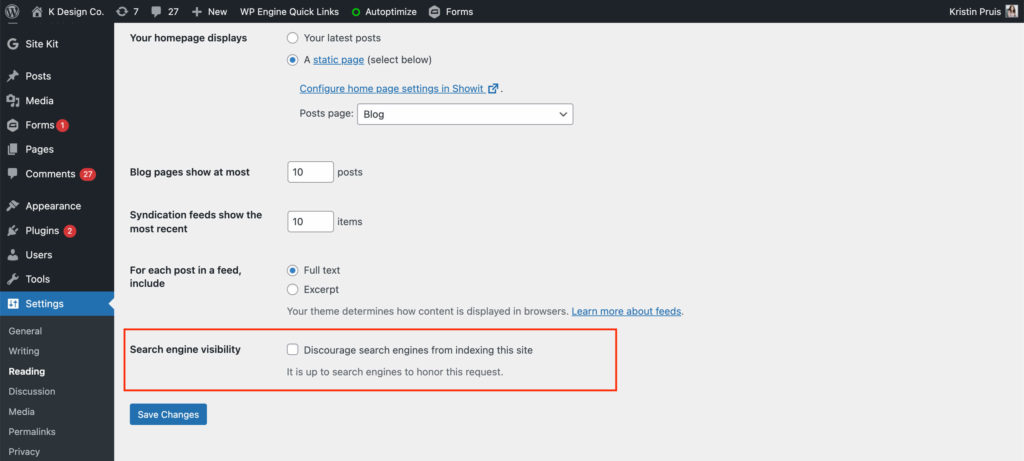
Next, you’ll want to ensure that all of your website’s pages and posts are set to “index” rather than “noindex”, unless you want certain content to be hidden from search engines. If your website is set to “noindex”, you can modify your website’s robots.txt file or meta tags to allow search engines to crawl and index your pages. The robots.txt file is a text file located at the root directory of a website that tells search engine crawlers which pages or sections of the site should be crawled and indexed.
How to modify your website’s robots.txt file to allow for search indexing
To modify the robots.txt file to allow for search indexing, follow these steps:
- Access your website’s root directory: The robots.txt file should be located at the root directory of your website, which can be accessed via FTP, cPanel, or a file manager provided by your web hosting service.
- Open the robots.txt file: Once you have accessed the root directory, locate the robots.txt file and open it in a text editor.
- Add the appropriate code: To allow all pages on your site to be indexed, you can use the following code:
User-agent: * Disallow:
This code tells all search engine crawlers to allow access to all pages on your site. Alternatively, if you only want to allow certain pages or directories to be indexed, you can specify them using the “Disallow” directive. For example, to allow all pages on your site except for the “/admin” directory, you could use the following code:
User-agent: * Disallow: /admin/
- Save and upload the modified file: Once you have made the necessary modifications to the robots.txt file, save the file and upload it to your website’s root directory. Make sure to test the modified file to ensure that it is working as intended.
By modifying your website’s robots.txt file, you can control which pages and directories are crawled and indexed by search engines, helping to improve the visibility and accessibility of your site.
SEO Mistake #2: You Aren’t Using SEO-Optimized Headings in Your Pages and Blog Posts
Headings are important for organizing content and helping readers betterr navigate and understand your website, but they can also help greatly improve your SEO. The key is to use relevant keywords that accurately describe the content on the page.
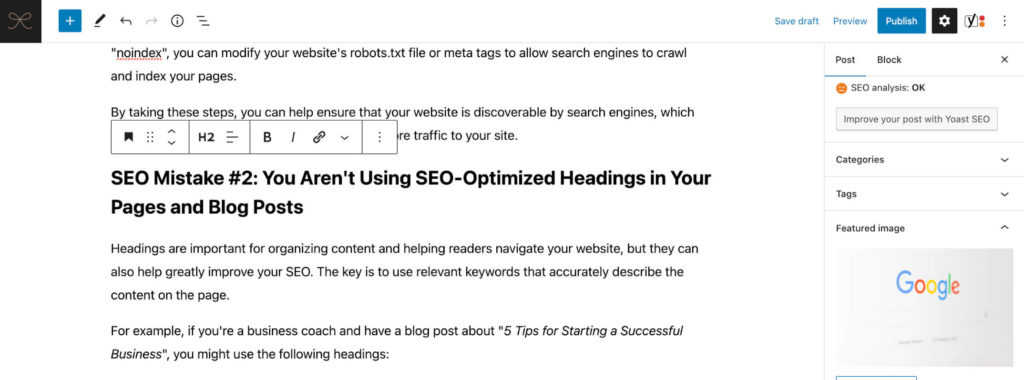
For example, if you’re a business coach and have a blog post about “5 Tips for Starting a Successful Business“, you might use the following headings:
H1: 5 Tips for Starting a Successful Business
- H2: Define Your Target Audience
- H2: Conduct Market Research
- H3: Know Your Industry Inside and Out
- H2: Create a Business Plan
- H3: Choose the Right Legal Structure
- H3: Secure Funding for Your Business
- H2: Build Your Online Presence
- H3: Develop a Strong Brand Identity
- H2: Network and Collaborate
These headings use relevant keywords and provide a clear hierarchy of information, which can help search engines understand what your page is about and how it relates to what your users are searching for.
You can define the heading levels for your page or post content inside of your website builder or platform where you would typically be able to edit your page. For WordPress users, this might mean inside the Gutenberg block editor like in the example shown above. Or in Showit, you can utilize the Text Properties settings to control your page headings.
SEO Mistake #3: You Aren’t Adding ALT Text to Your Images
ALT text is important for describing images to search engines and website visitors who may have difficulty viewing the image. If you’re a photographer, designer, content creator or other creative professional, this can be particularly important as your work is often visual.
For example, if you’re a wedding photographer and have an image of a couple in a field at sunset, the ALT text for this image could be “Couple in a field at sunset” or “Romantic couple photoshoot at sunset”. These descriptions are concise and accurate (meaning they’ll also improve your website’s accessibility), and they help search engines understand that the image is related to couples and photography.
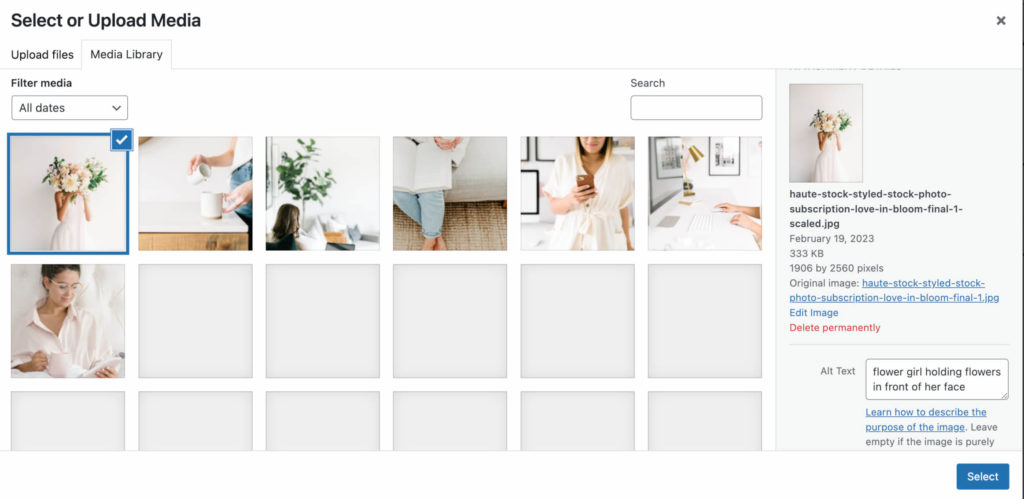
It’s important to note that depending on your website builder the ALT text field may be called something different. For example, in WordPress, it’s simply called ALT text, while in Showit, it’s called Description. And in other website builders it may be called something else.
In WordPress, you can add ALT text to your images through your Media Library when you upload your image or you can add it later in the image settings, once it has been inserted on your page. In Showit, you can add ALT text to your image under the SEO “Description” field that will display when you click on any image.
Related Post: How to Write Alt Text for Images: Best Practices & Examples
What’s the difference between ALT text and SEO Title?
Don’t get confused by these two similar, but different image properties. While the SEO ALT text field is used to provide alternative text for an image and can improve the accessibility of the page and help with SEO, the SEO title field for an image is used to provide a title for the image that appears when the user hovers over it.
This title does not actually always show, depending on your theme, but it can provide additional context for the user and make the page more user-friendly. However it doesn’t actually affect your SEO that much.
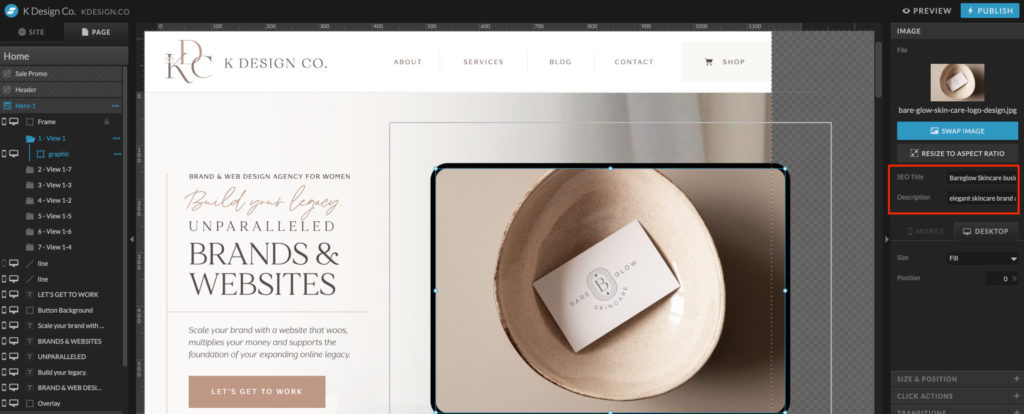
SEO Mistake #4: You Aren’t Requesting Indexing of Updated Content or New Pages Through Google Search Console
Adding new pages, blog posts and content to your website helps to keep your website, fresh and up-to-date, but you might be surprised to know that Google doesn’t always know immediately when you publish new content. Sometimes it can take days or even weeks to crawl that new content.
That’s why it helps to give Google a little nudge to let them know when you’ve made significant updates to page or published a timely blog post and notice that Google hasn’t seen it yet. Google crawls all websites at different frequencies, so requesting indexing of your entire site (after you have had a redesign) or a certain page (after you’ve updated the content) is a great trick to getting your content crawled more quickly. This will ensure that your new pages are indexed so that users can find them.
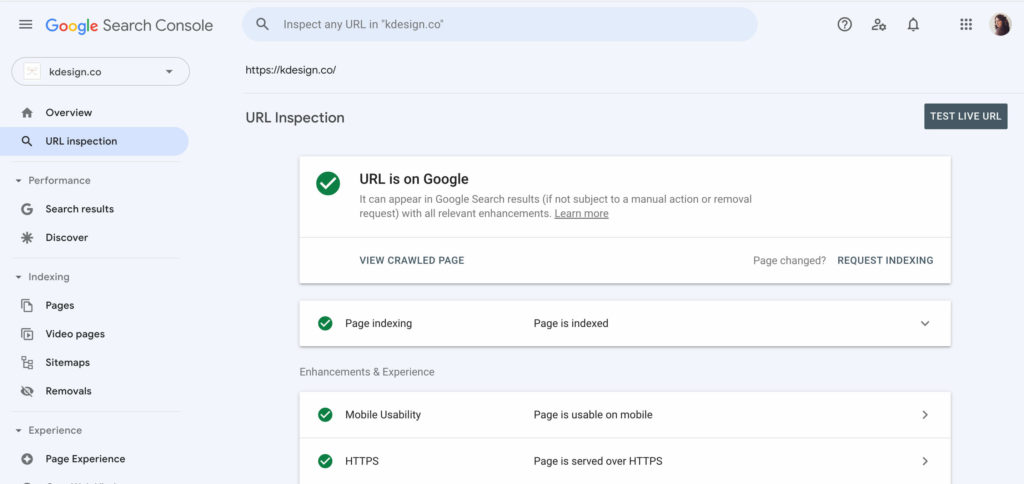
To request indexing, use Google Search Console’s URL Inspection tool. You should see something like the example above. Enter the URL of the new page and request indexing, which will prompt Google to crawl and index the page. If you don’t have a Google Search Console account, sign up for one – it’s free, and it’s a great tool to find key insights about what search terms users are using to find your website.
SEO Mistake #5: You’re Using the “Wrong” Keywords
Optimizing your website pages for relevant keywords can help your website rank higher in search engine results pages. However, using the highest volume keywords isn’t always the fast-track to ranking highly in search. If you’re website isn’t showing up in Google you could be using the wrong keywords. What does that mean? It can mean a lot of things, like…
- You are targeting highly competitive keywords that your website is unlikely to rank for. If your domain authority is 11 and you are trying to rank for a keyword that has a competition score of 90, it’s very, very unlikely you are going to outrank competitors for this term.
- You are targeting low volume keywords that not enough users are searching for. If your target work is less than 50-100 monthly searches, you would benefit from looking for a related keyterm that has higher search volume.
- You are targeting keywords that aren’t relevant to the users search intent. You found a keyword or phrase that has a low competitive score and a high volume – perfect! Except, if you look at the top 10 websites ranking for that term, they have nothing to do with what your page or post is talking about. The primary topic of the existing rankings for this term influence and signal the kind of related content that it is going to rank well also.
- You aren’t using a variety of keywords on your posts and pages. While it’s true you want to have a unique primary keyword focus for each post or page on your site, you should also be incorporating related keywords and phrases to capture a wider range of search intent and improve your overall search engine optimization (SEO) strategy. By including relevant secondary keywords and long-tail phrases, you can increase the visibility of your content to a larger audience and potentially drive more traffic to your website.
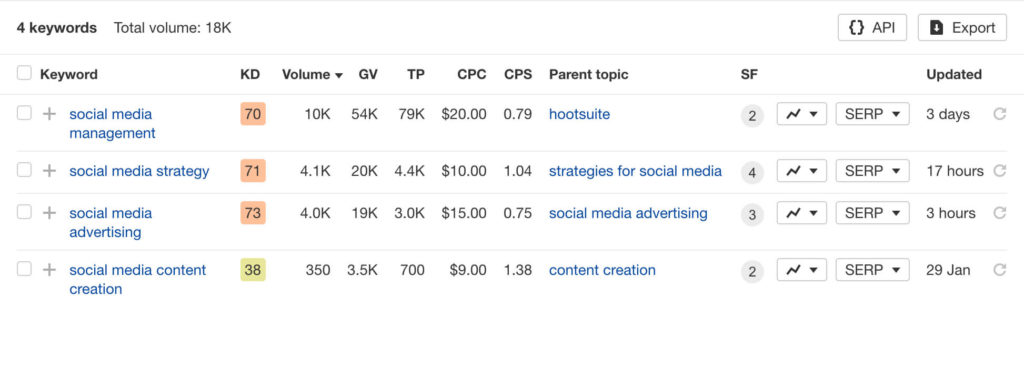
For example, if you’re a social media manager and you might want to optimize a page on your site for the keyword “social media management”. However you don’t just want to stop there. Use a keyword research tool like Ubersuggest or Ahrefs to find related keywords variations. Instead of just targeting “social media management”, you might also target keywords like “social media strategy”, “social media advertising”, and “social media content creation”.
The TLDR takeaway on SEO mistakes…
Overlooking some of these common SEO pitfalls can have a seriously negative impact on the amount of users who can find your website through organic search. By ensuring that your website is indexed, using SEO-optimized headings and ALT text, requesting indexing for new pages, and targeting the right relevant keywords, you can improve your website’s chances of ranking higher in search results.













